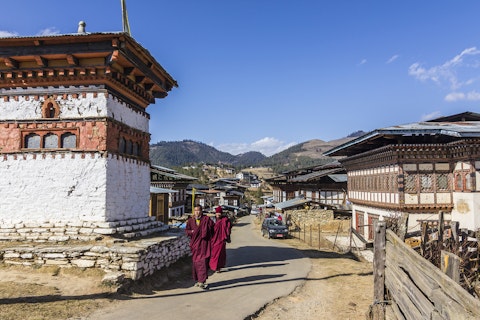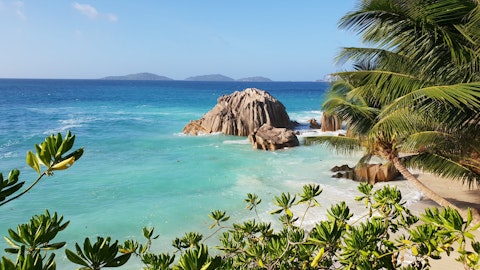In this insightful article, we will list the top developing landlocked countries and explain the trade bottlenecks they face because of geographic challenges. You can skip our overview of the challenges these nations face and head to 10 Landlocked Developing Countries.
Landlocked Developing Countries (LLDCs) face substantial hurdles in socio-economic development due to their lack of direct access to the sea. Their geography leads to isolation from global markets and elevated transit costs, placing a significant burden on these nations. For instance, landlocked emerging economies incur average transportation costs that are more than double those of transit countries through which they must route their exports. This situation leads to delayed timelines for sending and receiving overseas merchandise.
According to 2014 estimates by World Bank, the cost for LLDCs to export a container was $3,204, in stark contrast to the $1,268 borne by transit countries (those that have coastlines). Similarly, importing a container cost LLDCs $3,884, compared to the $1,434 for transit countries. We can expect a similar inflation-adjusted differences as of 2023 as well. From the perspective of heavy cargo shipments, businesses in landlocked developing countries bear substantial costs due to their geography.
Because of these higher trade costs, landlocked countries, on average, export less than half of the per-capita amount of their maritime/transit neighbors. Research shows that almost all landlocked countries export less per capita than their regional maritime counterparts. Regarding regional differences, landlocked countries in Western Africa, such as Mali and Burkina Faso, export merely 12% of what their maritime neighbors do. In contrast, Southern African LLDCs like Zambia, Zimbabwe, and Botswana export 70% of the per capita value of their sea-accessing neighbors.
LLDCs are situated far from seacoasts, with Kazakhstan, one of the biggest developing countries in the world, being the furthest at 3,750 km. Other countries including Afghanistan, Chad, Niger, Zambia, and Zimbabwe also experience significant remoteness, each being over 2,000 km away from the nearest coastline. These daunting distances, challenging terrains, and suboptimal road and rail conditions extend the transit times for goods considerably, limiting economic prospects for developing countries without coastlines.
In the World Bank’s Logistics Performance Index (a tool evaluating trade and transport-related infrastructure quality among other factors), most bottom performers are identified as either low or lower-middle-income countries. These economies, often struggling with political turmoil, armed conflict, or geographical challenges as landlocked nations, find their connection to global supply chains obstructed. These conditions underscore the problems LLDCs encounter due to their geographical location, adversely affecting their economic prospects.
Foreign Direct Investment In Landlocked Developing Countries
Despite the considerable transportation expenses that undermine the competitive positions of LLDCs in the global market, the Fastest Developing Countries in 2023 still attract sufficient foreign direct investment. UNCTAD’s World Investment Report of 2023 highlights that foreign direct investment in landlocked developing countries rose by 6% in 2022, reaching $20 billion, with Kazakhstan, Ethiopia, and Uzbekistan being the top recipients.
Kazakhstan, the world’s largest landlocked country, experienced an 83% increase in its FDI in FY 2022 due to high expected earnings from the extractive industries. The principal foreign investors in Kazakhstan have been the Netherlands, the US, and Switzerland. They have primarily focused on developing the country’s mineral, petroleum, and natural gas resources. According to the US Department of State, the US’s FDI stock in Kazakhstan has reached $43.48 billion, concentrating on its hydrocarbon and mineral sectors.
Similarly, China is the most significant investor in Ethiopia, accounting for over 60% of approved FDI projects in the country. Ethiopia’s strategic location in the Horn of Africa provides China with a gateway to other markets in Africa and the Middle East. Furthermore, Trading Economics reports that Ethiopia’s overall FDI jumped from $676 million in 2011 to a record $1.907 billion in 2023 due to its status as one of the fastest-growing economies in Africa. This investment surge in LLDCs occurred while global FDI levels dropped by 12% in 2022 due to interest rate hikes and inflation.
Several corporations have invested heavily in LLDCs to help extract fossil fuels and convert them into usable commodities as many landlocked developing countries possess some form of mineral resources. For example, Chevron Corp (NYSE:CVX), an integrated energy company based in California, has partnered with Kazakhstan for three decades to develop its energy resources. This collaboration has aided Kazakhstan in emerging as one of the world’s major energy producers and exporters.
Chevron Corp (NYSE:CVX) has significantly invested in Tengizchevroil (TCO), Kazakhstan’s largest crude oil-producing field, multiplying its annual gross production of oil fifteen-fold between the 1990s and 2020s. Chevron Corp (NYSE:CVX) owns 50% equity in the Tengizchevroil oil field and has supported Kazakhstan’s economy through direct spending of $14.1 billion in the past decade. Notably, Chevron’s tax contributions and royalties comprise 15% of the government’s income in Kazakhstan, and the company’s local expenditures further contribute to a 2% income increase.
If giants in the shipping, logistics, and extractive industries continue investing in these developing economies, these nations will likely experience enhanced economic prospects, regardless of their geographical constraints.
Let’s now move to developing countries without access to sea routes.

anandoart/Shutterstock.com
Our Methodology
We created a list of 32 landlocked developing countries from the United Nations’ classification of LLDCs and ranked them based on their GDP per capita to highlight their level of development. We sourced the GDP per capita data for these LLDCs from The World Bank and listed the nations in ascending order of their per capita GDP.
Based on our findings, here are 32 landlocked developing nations:
32. Burundi
GDP Per Capita: $238
Burundi, a small East African country, relies heavily on subsistence agriculture and grapples with persistent political instability. The nation depends significantly on the Tanzanian port of Dar es Salaam for international trade, resulting in complicated and costly export-import activities, which hinder economic development.
31. Afghanistan
GDP Per Capita: $363
Afghanistan, a landlocked country in South and Central Asia, is known for its rugged terrain and strategic location. Political turmoil and ongoing conflicts severely restrict its economic activities, significantly impacting trade and development. The country predominantly depends on neighboring Pakistan and Iran for seaport access.
30. Central African Republic
GDP Per Capita: $427
The landlocked Central African Republic (CAR) faces economic challenges compounded by underdeveloped infrastructure. Relying on the Cameroonian port of Douala for international trade makes the route lengthy and costly, hindering the nation’s efforts to improve its struggling economy.
29. Niger
GDP Per Capita: $533
Niger aims to alleviate poverty through increased trade but is reliant on access to international markets via neighboring countries’ ports, mainly in Benin. The costs associated with transit, customs clearance, and shipping in these countries heighten Niger’s trade expenses. Despite these challenges, the government is actively engaged in regional partnerships to enhance trade capabilities.
28. Malawi
GDP Per Capita: $645
With an overreliance on agriculture and underdeveloped infrastructure, Malawi depends primarily on Mozambique’s ports for international trade. This dependence results in high costs and complexity in export and import activities, though there is an ongoing effort to improve transportation networks to bolster trade prospects.
27. Chad
GDP Per Capita: $716
Located in north-central Africa, Chad contends with inadequate infrastructure and dependence on oil and agriculture. Like CAR, Chad conducts its sea trade via the Douala port in Cameroon, facing expensive and logistically challenging international trade processes.
26. Burkina Faso
GDP Per Capita: $832
Burkina Faso uses Côte d’Ivoire as its transit country due to its direct access to the Atlantic Ocean. The country primarily exports gold, cotton, zinc, and livestock, with Singapore, Ivory Coast, and Switzerland being its main import partners.
25. Mali
GDP Per Capita: $833
Mali, a West African nation, faces a volatile security situation with gold and agriculture as its main revenue sources. Due to its landlocked status, ports in Senegal and Côte d’Ivoire are crucial for Mali’s international trade.
24. Uganda
GDP Per Capita: $964
Uganda, located in East Africa, relies on the Kenyan port of Mombasa for access to the Indian Ocean. Its most profitable exports include coffee, tea, paper, and oil. Uganda is making substantial efforts to improve its road networks, rail systems, and regional partnerships to facilitate smoother trade routes.
23. Rwanda
GDP Per Capita: $966
Located in East Africa, Rwanda primarily uses ports in Tanzania and Kenya, and this geographic disadvantage increases trade costs, substantially affecting the economy. Since the 1994 genocide, Rwanda has undergone a remarkable transformation, emerging as one of Africa’s most stable and orderly countries. The government, under the leadership of President Paul Kagame, has initiated a series of economic reforms that have brought about significant improvements in the country.
22. Ethiopia
GDP Per Capita: $1,027
Ethiopia, an East African nation, is the continent’s second-most populous country. Although landlocked, Ethiopia has pursued economic development through industrialization, infrastructure enhancement, and promotion of its growing textile and coffee industries. China has made significant investments in Ethiopia, accelerating momentum in the country’s business sector.
21. Tajikistan
GDP Per Capita: $1,054
Located in Central Asia, Tajikistan boasts mountainous terrain covering over 90% of its landscape. The nation’s economy relies heavily on remittances, mining, and agriculture.
20. South Sudan
GDP Per Capita: $1,071
South Sudan, the world’s youngest nation, is striving to stabilize and grow its economy amidst ongoing conflict. Although landlocked and situated in East-Central Africa, the country primarily depends on oil production but is actively working to diversify its economy.
19. Lesotho
GDP Per Capita: $1,107
Lesotho, entirely surrounded by South Africa, is unique as the only independent state globally situated above 1,000 meters in elevation. Though its economy is closely tied to its neighbor, Lesotho is developing its textile, agriculture, and tourism sectors, despite geographic challenges.
18. Zimbabwe
GDP Per Capita: $1,267
Despite enduring economic challenges due to political instability and sanctions, resource-rich Zimbabwe persists. The landlocked nation has significant mineral wealth and a well-educated populace, working diligently to leverage these assets for economic recovery.
17. Nepal
GDP Per Capita: $1,336
Nepal is located in the Himalayas between China and India and possesses significant hydropower potential. The country’s rich cultural heritage not only attracts tourism but also supports its economy.
16. Zambia
GDP Per Capita: $1,487
Zambia, a landlocked nation in southern Africa, is rich in natural resources, including copper. Although its economy has historically been grounded in mining, there is a growing emphasis on diversification into agriculture, tourism, and manufacturing to reduce dependency on minerals.
15. Kyrgyzstan
GDP Per Capita: $1,606
Kyrgyzstan, another Central Asian nation among LLDCs, has mountainous terrain and lacks a coastline. The nation effectively capitalizes on its abundant natural resources, robust agriculture sector, and strategic location along the ancient Silk Road to promote trade and economic development initiatives.
14. Lao People’s Democratic Republic
GDP Per Capita: $2,088
The Lao People’s Democratic Republic, or Laos, leverages its strategic location in Southeast Asia. Engaged in regional economic cooperation, the country focuses on hydroelectric power, agriculture, and tourism, positioning itself as a crucial connector between its neighboring countries. It is one of the landlocked developing countries of most interest as far as economic growth goes.
13. Uzbekistan
GDP Per Capita: $2,255
Uzbekistan, a doubly landlocked Central Asian nation, is known for its rich historical heritage and abundant natural resources, including cotton and gold. With a per capita GDP of $2255, the country reached an export value of $3.1 billion in 2022, with Russia being its largest importer.
12. Bhutan
GDP Per Capita: $3,266
Sitting in the Eastern Himalayas, Bhutan is globally acclaimed for prioritizing Gross National Happiness over GDP. This distinctive approach shapes its socio-economic policies, which are deeply rooted in the nation’s religious teachings. The country also champions sustainable tourism and hydroelectric power as key economic drivers, all while maintaining a steadfast commitment to environmental conservation.
11. Bolivia (Plurinational State of)
GDP Per Capita: $3,523
As one of the two landlocked developing countries in South America, Bolivia boasts abundant natural resources, including the largest lithium reserves by country. The nation is now prioritizing industrialization to foster indigenous entrepreneurship and engage in regional economic initiatives.
Click to continue reading 10 Landlocked Developing Countries.
Suggested Articles:
- 30 Heavily Indebted Poor Countries
- 25 Countries that Receive the Most Foreign Aid Per Capita
- 20 Poorest Countries in Asia
Disclosure: None. 32 Landlocked Developing Countries was originally published at Insider Monkey.





